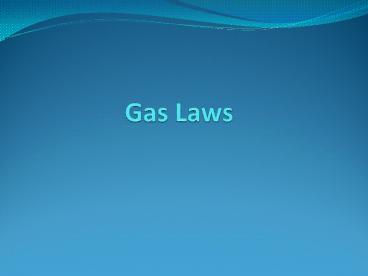Gas Laws - PowerPoint PPT Presentation
Title:
Gas Laws
Description:
Page 1 Kinetic Molecular Theory Is a theory that demonstrates how gases should behave. It is also called Ideal Gas Laws . Kinetic Molecular Theory Gas ... – PowerPoint PPT presentation
Number of Views:136
Avg rating:3.0/5.0
Title: Gas Laws
1
Gas Laws
2
Page 1
3
Kinetic Molecular Theory
- Is a theory that demonstrates how gases should
behave. - It is also called Ideal Gas Laws.
4
Kinetic Molecular Theory
- Gas particles are in random, constant,
straight-line motion. - Gas particles are separated by great distances
relative to their size the volume of the gas
particles is considered negligible. - Gas particles have no attractive forces between
them. - Gas particles have collisions that may result in
a transfer of energy between gas particles, but
the total energy of the system remains constant.
5
Hydrogen and Helium
- Follow the Ideal Gas Law or KMT.
6
Real Gases Deviate From KMT
- The volume of gas particles is significant. Gas
particles DO have volume.
- Gas particles DO have a force of attraction.
- The two deviations are significant under high
pressure and low temperature (molecule are closer
together).
7
Page 2
8
Pages 7-8
9
Page 3
10
Boyles Law
- P
- V
- Observation
11
Boyles Law
- As pressure increases, volume decrease.
- Formula P1V1 P2V2
- (Temperature and number of particles are constant)
12
Page 11
- Questions
- 3 4 6 8 - 10
Page 12
- Questions
- 1 4 6 9
13
Charles s Law
- V
- T
- Observation
14
Charles s Law
- The higher the temperature (Kelvin), the bigger
the volume. - Formula V1 V2
- T1(Kelvin) T2 (Kelvin)
- Pressure is Constant
15
Page 11
- Questions
- 2 7 9 - 12
Page 12
- Questions
- 3 5 7 8 - 10
16
Gay Lussacs Law
- P
- T
- Observation
17
Gay Lussacs Law
- The higher the temperature (Kelvin), the higher
the pressure. - Formula P1 P2
- T1(Kelvin) T2 (Kelvin)
- Volume is constant
18
Combined Gas Law
- Formula P1V1 P2V2
(Table T) - T1(Kelvin) T2 (Kelvin)
- Table A - STP
- May be used to solve any of the previous gas law
problems.
19
Page 9-10
20
Page 5
21
Avagadros Hypothesis
- Equal volumes of all gases under the same
conditions of temperature and pressure have equal
numbers of molecules. - Avagadros Number 6.02 x 1023
- One liter of hydrogen has the same number of
molecules as one liter of oxygen. - 1 mole 6.02 x 1023 particles/mol
- 1 mole of a gas occupies 22.4 liters at STP
22
Page 6































